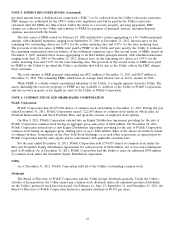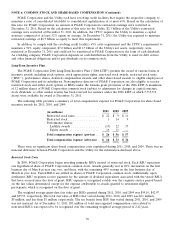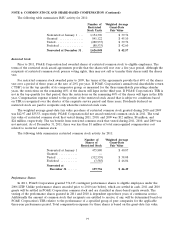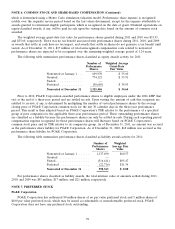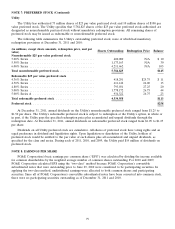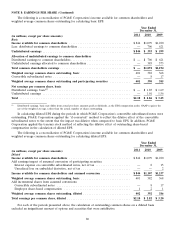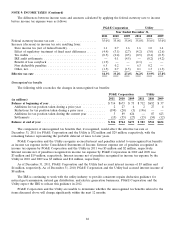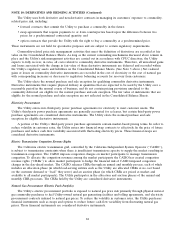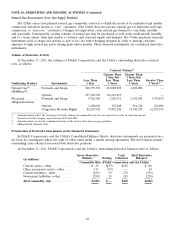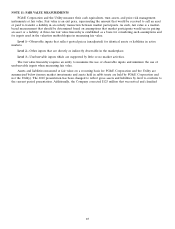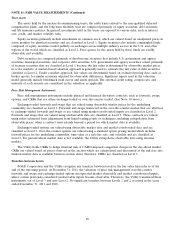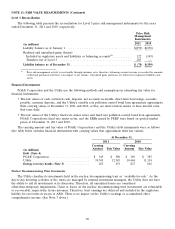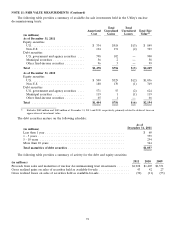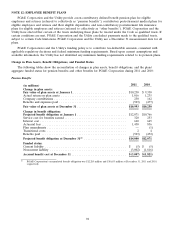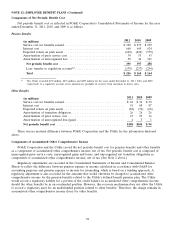PG&E 2011 Annual Report Download - page 89
Download and view the complete annual report
Please find page 89 of the 2011 PG&E annual report below. You can navigate through the pages in the report by either clicking on the pages listed below, or by using the keyword search tool below to find specific information within the annual report.
NOTE 10: DERIVATIVES AND HEDGING ACTIVITIES (Continued)
Natural Gas Procurement (Core Gas Supply Portfolio)
The Utility enters into physical natural gas commodity contracts to fulfill the needs of its residential and smaller
commercial customers known as ‘‘core’’ customers. (The Utility does not procure natural gas for industrial and large
commercial, or ‘‘non-core,’’ customers.) Changes in temperature cause natural gas demand to vary daily, monthly,
and seasonally. Consequently, varying volumes of natural gas may be purchased or sold in the multi-month, monthly,
and to a lesser extent, daily spot market to balance such seasonal supply and demand. The Utility purchases financial
instruments such as swaps and options as part of its core winter hedging program in order to manage customer
exposure to high natural gas prices during peak winter months. These financial instruments are considered derivative
instruments.
Volume of Derivative Activity
At December 31, 2011, the volumes of PG&E Corporation’s and the Utility’s outstanding derivative contracts
were as follows:
Contract Volume(1)
Greater Than Greater Than
1 Year but 3 Years but
Less Than Less Than Less Than Greater Than
Underlying Product Instruments 1 Year 3 Years 5 Years 5 Years(2)
Natural Gas(3) ..... Forwards and Swaps 500,375,394 212,088,902 6,080,000 —
(MMBtus(4))
Options 257,766,990 336,543,013 ——
Electricity ....... Forwards and Swaps 4,718,568 5,206,512 2,142,024 3,754,872
(Megawatt-hours)
Options 1,248,000 132,048 264,348 264,096
Congestion Revenue Rights 84,247,502 72,882,246 72,949,250 61,673,535
(1) Amounts shown reflect the total gross derivative volumes by commodity type that are expected to settle in each time period.
(2) Derivatives in this category expire between 2017 and 2022.
(3) Amounts shown are for the combined positions of the electric fuels and core gas portfolios.
(4) Million British Thermal Units.
Presentation of Derivative Instruments in the Financial Statements
In PG&E Corporation’s and the Utility’s Consolidated Balance Sheets, derivative instruments are presented on a
net basis by counterparty where the right of offset exists under a master netting agreement. The net balances include
outstanding cash collateral associated with derivative positions.
At December 31, 2011, PG&E Corporation’s and the Utility’s outstanding derivative balances were as follows:
Gross Derivative Cash Total Derivative
Balance Netting Collateral Balances
(in millions)
Commodity Risk (PG&E Corporation and the Utility)
Current assets—other ............ $ 54 $(39) $103 $ 118
Other noncurrent assets—other ..... 113 (59) — 54
Current liabilities—other .......... (489) 39 274 (176)
Noncurrent liabilities—other ....... (398) 59 101 (238)
Total commodity risk ............. $(720) $ — $478 $(242)
85


